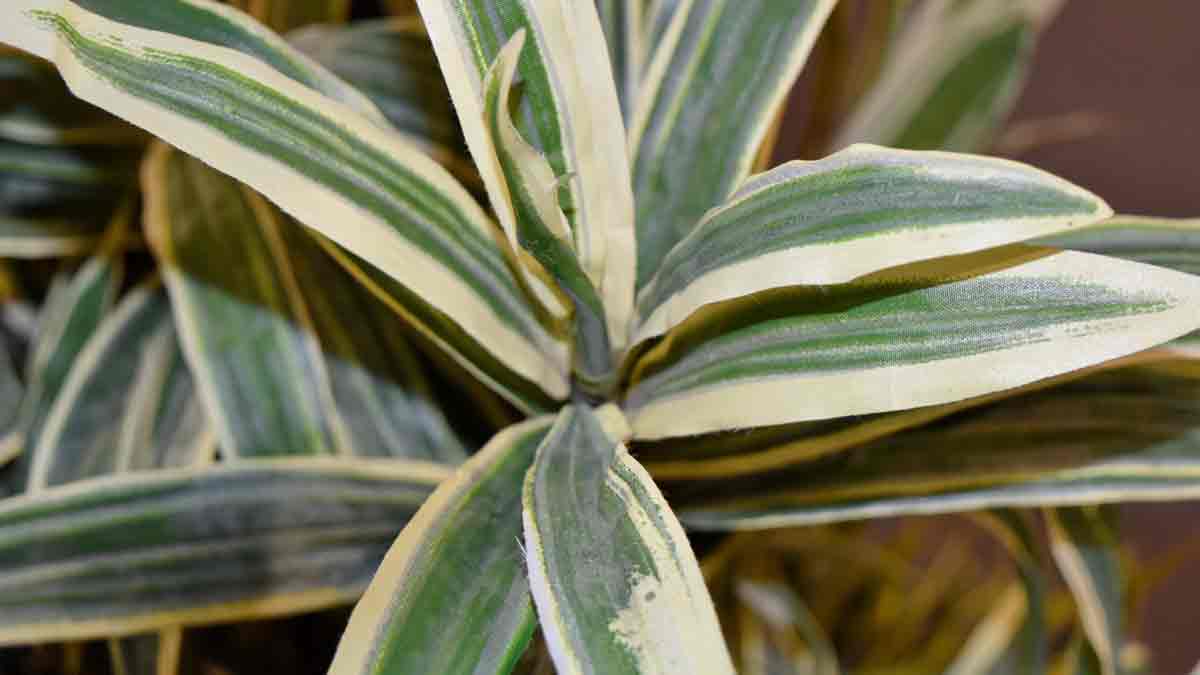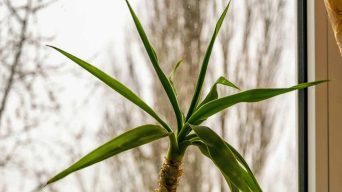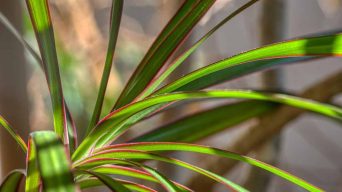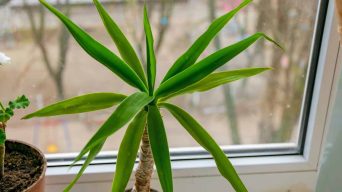Dracaena plants are beautiful, easy-to-care-for houseplants that can thrive indoors for many years.
Though they are relatively low-maintenance, they can sometimes experience problems, such as their leaves turning black.
Although it may be alarming to see your plant’s leaves turn black, it is usually not a cause for concern.
In most cases, the issue can be easily fixed.
Why Are My Dracaena Leaves Turning Black and How Can You Fix It?
There are a few reasons your Dracaena’s leaves might turn black.
The most common causes are overwatering, fungal diseases, and pests.
Other potential causes include exposure to too much light or cold temperatures, fertilizer issues, and water quality.
Here are a few of the most common reasons for Dracaena leaves turning black, along with what you can do to fix the problem.
1. Overwatering
Overwatering is one of the leading causes of Dracaena leaves turning black.
When the plant’s roots are constantly saturated, they begin to suffocate and rot.
This inhibits the plant’s ability to uptake water and nutrients and can lead to fungal growth.
Fungi thrive in moist environments and can quickly spread through a plant, causing its leaves to turn black.
In severe cases, overwatering can kill a Dracaena outright.
How To Fix It
If you think your Dracaena plant is being overwatered, the best action is to stop watering it for a week or two and see if the leaves start to recover.
You can also try to improve drainage by adding perlite or sand to the potting mix.
If the problem persists, it is best to repot the plant in a fresh, well-draining potting mix.
2. Fungal Diseases
Dracaena plants are susceptible to a few fungal diseases, the most common being root rot and leaf spot.
Root Rot
Root rot is one plant disease that can cause Dracaena leaves to turn black.
Root rot is caused by a fungus that attacks the plant’s roots, causing them to rot.
The fungi responsible for root rot thrive in wet, poorly-drained soils. When the roots of the plant are exposed to these conditions, they become infected with the fungi.
The infection then spreads to the stems and leaves of the plant, causing them to turn black. In some cases, the entire plant may die.
How To Fix It
If you think your plant has root rot, the best course of action is to remove it from the pot and inspect the roots.
If they are black and mushy, they are probably infected with the fungi.
The best way to treat root rot is to trim the affected roots and repot the plant in a fresh, well-draining potting mix.
If the infection has spread to the stems and leaves, you may need to treat the plant with a fungicide.
Leaf Spot
A variety of fungi causes this problem, and it can lead to unsightly black spots on the leaves.
The spores of these fungi are spread by wind, water, and even insects, and they can quickly take hold in dracaena plants that are not well-protected.
Once the spores have germinated, they will begin to produce enzymes that break down the cell walls of the leaves.
This damage will cause the leaves to turn black and eventually fall off.
How To Fix It
If your plant is affected by leaf spot, you will need to remove the affected leaves and dispose of them.
You can also try treating the plant with a fungicide.
It is important to note that fungicides will only work if applied before the spores have germinated.
Once the fungi have taken hold, they are much more challenging to treat.
3. Pest Infestation
Pests are another common problem that can cause Dracaena leaves to turn black.
Aphids, spider mites, and mealybugs are all common pests that feed on the sap of plants. As they feed, they inject toxins into the plant that can cause the leaves to turn black.
In some cases, the pests will cause Dracaena leaves to droop, curl, or become covered in unsightly black spots.
Aphids
Aphids are small, sap-sucking insects that can cause extensive damage to Dracaena plants.
These pests are typically found on the undersides of leaves, where they feed on plant juices.
Aphids secrete a sticky substance known as honeydew, which can attract other pests and promote the growth of sooty mold.
In addition, aphids can transmit viral diseases from one plant to another.
How To Fix It
To effectively control aphids, it is essential to use a combination of cultural and chemical controls.
Prune infested leaves and stems to remove the pests.
In addition, wash the plants with a strong stream of water to remove any remaining aphids.
Treat the plants with insecticide soap or neem oil for heavy infestations.
This should be done early morning or evening to avoid harming beneficial insects.
Spider Mites
Spider mites are tiny spider-like pests that feed on the sap of plants. These pests are most active in warm, dry conditions.
They typically attack the undersides of leaves, where they puncture the cells and suck out the contents.
As they feed, spider mites release toxins that can cause the leaves to turn yellow, brown, or black.
In addition, the pests may also cause the leaves to curl, distort, or become covered in unsightly webbing.
How To Fix It
To get rid of spider mites, spray the plant with water.
This will wash away some of the creatures and make it harder for them to lay their eggs.
Next, mix up a soap and water solution and use it to wipe down the plant’s leaves.
Be sure to get under the leaves, as that is where spider mites like to hide.
Finally, treat the plant with insecticide soap or neem oil.
This natural oil will kill spider mites on contact and help prevent them from returning.
Mealybugs
Mealybugs are tiny, sap-sucking pests that can cause extensive damage to Dracaena plants.
These pests are most often found in warm, humid climates.
They typically attack the stems and leaves of plants, where they feed on the sap.
As they feed, mealybugs excrete a sticky substance called honeydew.
This honeydew can attract other pests, such as ants and sooty mold fungi.
Mealybugs can also spread plant diseases.
How To Fix It
If you suspect that your Dracaena plant has mealybugs, you can do a few things to get rid of them.
First, inspect the plant carefully and look for signs of infestation, such as white, cottony growths on the stems or leaves.
If you find mealybugs, they can be removed by hand or with a cotton swab dipped in alcohol.
You can also treat mealybugs with insecticidal soap or neem oil, which will kill them on contact.
4. Too Much Sunlight
Dracaena plants are native to tropical regions and grow in filtered sunlight.
In general, these plants prefer bright indirect light.
The leaves can develop sunburn if they are exposed to direct sunlight for too long.
This will cause the leaves to turn brown or black and may also cause them to become papery and brittle.
The plant’s natural defenses are overwhelmed, and the cells are damaged.
In some cases, the damage may be only cosmetic, but it can also lead to leaf drop or stunted growth.
How To Fix It
If your Dracaena plant is getting too much sun, the best thing to do is move it to a location with brighter indirect light.
When grown indoors, these plants should be placed near an east- or west-facing window.
This will give them the bright light they need without exposing them to direct sunlight.
When moving your plant, be sure to do so slowly and gradually.
This will give the plant time to adjust to its new location and prevent further stress or damage.
If the leaves are already damaged, you can try trimming them off.
This will allow the plant to focus its energy on new growth.
5. Cold Temperatures
Dracaena plants are tropical plants that prefer warm temperatures.
They will not tolerate temperatures below 50°F (10°C).
If the temperature dips too low, the leaves can turn brown or black and may eventually drop off the plant.
The plant may also stop growing and become stunted.
Cold damage is often irreversible, so it’s essential to take steps to protect your indoor plant from the cold.
How To Fix It
If your Dracaena plant is exposed to cold temperatures, the best thing to do is move it to a warmer location.
If possible, bring the plant indoors where the temperature can be controlled.
If you can’t bring the plant indoors, try to protect it from the cold by covering it with a blanket or tarp.
You can also use a grow light to provide extra warmth.
6. Fertilizer Burn
Dracaena plants need to be fertilized regularly to stay healthy and grow properly.
However, if you use too much fertilizer, or if the plant is not getting enough water, the roots can become burned.
This will cause the plant leaves to turn brown or black, eventually killing the plant.
How To Fix It
If you think your Dracaena plant has fertilizer burn, the best thing to do is stop fertilizing it and flush the roots with water.
To do this, water the plant thoroughly and then let the excess water drain away.
This will help remove any remaining fertilizer from the roots and prevent further damage.
Fertilize your plant when it is actively growing, and use a balanced fertilizer diluted to half the recommended strength.
7. Water Quality
The quality of the water you use to water your Dracaena plant can also affect its health.
If the water is too hard, it can build up in the soil and cause the leaves to turn brown or black.
Tap water is often high in minerals, which can harm plants.
The plants can also be sensitive to chemicals such as chlorine and fluoride.
Testing the pH level shows you if the water is too hard.
The ideal pH level for Dracaena plants is 6.0 to 7.0.
How To Fix It
If you think the water you’re using is too hard, the best thing to do is switch to distilled or filtered water.
You can also let tap water sit for a day or two before using it to allow the chemicals to evaporate.
Regularly testing your soil’s pH level will help you catch any problems early and take steps to fix them.
How To Prevent Black Leaves On Dracaena Plants
The best way to prevent black leaves on Dracaena plants is to provide them with the proper care.
There are several things you can do to make sure your Dracaena stays healthy:
- Place the plant in a location where it will receive bright indirect light.
- Water the plant regularly, and allow the soil to dry out between waterings.
- Don’t let the plant sit in water, as this can lead to root rot.
- Provide the plant with a well-draining potting soil mix.
- Fertilize the plant when it is actively growing, using a balanced fertilizer diluted to half the recommended strength.
- Prune off any dead or dying leaves as soon as you see them.
- Remove any debris from the plant’s pot on a regular basis.
- Inspect the plant regularly for signs of pests, and treat accordingly if you see any.
Following these simple tips can help prevent black leaves on your Dracaena plant.
Final Thoughts
Dracaena, the Dragon Tree, are popular for indoor plants because they are easy to care for and relatively forgiving of common mistakes.
However, even the most experienced gardener can sometimes run into problems.
One of these problems is Dracaena leaves turning black.
There are several reasons why this might happen, including pests, disease, and improper care.
If you notice your Dracaena plant’s leaves turning black, the best thing to do is inspect the plant carefully and try to identify the cause.
Once you know what’s causing the problem, you can take steps to fix it.
Your Dracaena plant should soon return to its healthy self with proper care.







